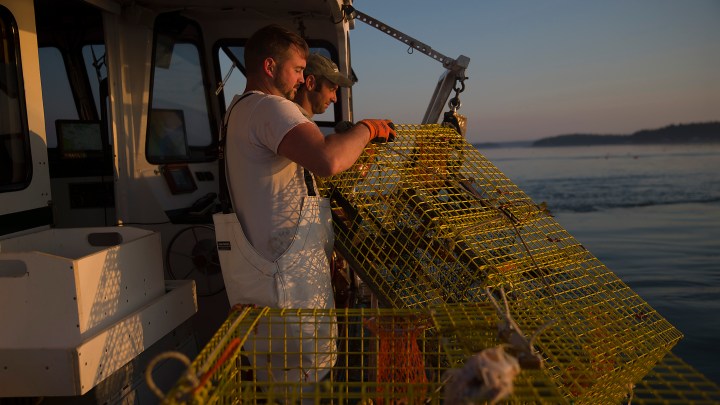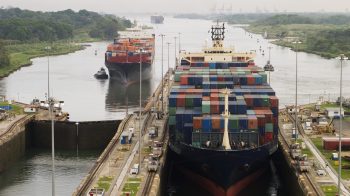
Ocean acidification raises economic concerns for shellfish hatcheries
Ocean acidification raises economic concerns for shellfish hatcheries

At Whiskey Creek Shellfish Hatchery on the Oregon coast, baby oysters are hatched, raised, then sold to oyster farms throughout the Pacific Northwest.
“Our pumps pump in about 200 gallons a minute of seawater into the hatchery,” said production manager Alan Barton.
The seawater comes in, gets treated and goes into tanks where the oysters are hatched. Barton grows vats of green and brown algae to feed them. Back in 2007, after nearly 30 years of doing this without incident, something started to go wrong.
“Just month after month after every group of larvae dying one after another,” Barton said. Entire crops of baby oysters — normally swimming around — just died.
“We thought the causes were things like bacteria, disease,” he said. So they treated the water for bacteria.
“[In] 2008, with all these sophisticated treatment systems in place, we essentially lost all the larvae in the entire hatchery — $100,000 worth of product — and all just went to the bottom, all within 48 hours or so,” he said.
More acidic water, more problems
The cause, it turned out, was the water itself. More acidic water from deeper in the ocean was upwelling into their water source, driven by seasonal winds.
The lower pH water, meaning it was more acidic, was driving changes in the mineral composition of the water and killing the oyster babies. Deeper water is naturally more acidic than surface water, and upwelling is a natural event. But human-caused emissions are increasing the background level of acidity and appear to have tipped those natural conditions just past what the oyster larvae could bear.
“The ocean takes up about 25% to 30% of the carbon dioxide that is emitted, and in doing so it lowers the pH of the ocean,” said George Waldbusser, professor of ocean ecology and biogeochemistry at Oregon State University.
“It also lowers something we call the saturation state, which is how corrosive the water is to calcium carbonate minerals or shells,” he said. The saturation state represents the availability of minerals in the water and is distinct from pH, but it is influenced by it and other factors.
Waldbusser said the pH of open ocean water has fallen since carbon dioxide emissions ramped up with industry about 100 years ago from 8.1 to 8. “It sounds small, but what that actually translates to is a 30% increase in acidity,” he said.
On the pH scale, any level below 7 is considered acidic; above 7 is basic. So when the ocean surface pH drops from 8.1 to 8, the ocean is still basic, but its acidity has increased.
The World Meteorological Organization reported earlier this year that the oceans are the most acidic they’ve been in 26,000 years, and that this is due to human-caused emissions of carbon dioxide, like burning fossil fuels.
A problem decades in the making
Shannon Meseck studies the effects of carbon dioxide in the water. She’s a research chemist for the National Oceanic and Atmospheric Administration in Milford, Connecticut. In her lab, tanks of seawater are dosed with carbon dioxide to simulate the effects of ocean acidification.
She’s grown surf clams, sea scallops, oysters and currently bay scallops. Adult oysters are resilient to acidification, but baby oysters essentially have to fight the water for minerals to grow their shells. They use up their energy reserves and die of starvation trying.
Meseck’s research shows lowering the pH affects the physiology of a variety of shelled animals, “and this is resulting in less energy that’s available for them to grow.”
Shells were smaller, and in some cases — like with surf clams — their insides were smaller. “They were also putting on less meat muscle, and you eat the meat,” Meseck said.
Thirty to 40 years ago, the higher-pH, more-acidic water currently upwelling on the Oregon coast was surface water in the Sea of Okhotsk, off the Russian coast north of Japan. That’s according to Burke Hales, professor of ocean ecology and biogeochemistry at Oregon State University.
That was the last time this water saw the surface, and that is when it was exposed to industrial-era levels of carbon dioxide. Over the next several decades, it traveled as deep as 500 meters, carrying with it those carbon dioxide emissions and gaining acidity through natural processes. Eventually, it arrived on the Oregon coast and started wiping out larval oysters in hatcheries.
What this means, Hales said, is that water currently in the Sea of Okhotsk is absorbing even higher levels of emissions and will arrive on the Oregon coast decades from now.
“We’ve sent a package that we can’t stop delivery on,” he said.
The changing landscape of aquaculture
Translating all of this into economic costs is not straightforward. For example, some shellfish may be able to evolve resistance to acidification — something Meseck’s lab is working on assessing. Some hatcheries are trying to breed resistance. And there is a lot of natural variability in acidity from place to place.
“Ocean chemistry is different than the chemistry of inland waters. The vulnerability to acidification is pretty different across space,” said Jeremy Testa, an associate professor at the University of Maryland Center for Environmental Science. It can’t be ruled out, he said, that some aspects of climate change could benefit some organisms or locations.
Oyster hatcheries in the Chesapeake Bay don’t face the same problems as those in Oregon, for example. And hatcheries like Whiskey Creek have managed to treat their water with sodium carbonate to lower its pH once they figured out the problem. The solution was a minimal cost — though it took a few years and hundreds of thousands of dollars in losses.
It’s the cost of adaptation and mitigation that could be prohibitive in individual cases as conditions continue to change, said Lisa Wainger, research professor at the University of Maryland Center for Environmental Science.
“This might change the landscape of aquaculture,” she said. Some areas may diminish while others would increase production. It’s doable but disruptive and costly to communities.
Economically important species grown in controlled environments may receive attention and efforts to cope with ocean acidification.
“The wild-catch fisheries are going to be more susceptible to change because they don’t manage any aspects of the environment,” Wainger said.
One of many threats to hatcheries
Scientists are exploring options, however. OSU’s George Waldbusser is involved with experiments depositing shells into coastal waters to alter the local water conditions there. But species that grow in the wild off the radar of human economics won’t have the benefit of human efforts to protect them.
But ultimately, the direct economic cost of ocean acidification is perhaps best understood as simply being one more problem to deal with on top of a pile created or made worse by humans.
“In the last couple of years, we have had other changes to the ecosystem of the water that is pumped into our hatchery that have really affected our seed oyster production,” said Meredith White, director of research and development at Mook Sea Farm in Maine.
Things like increased rainfall diluting the coastal water, changes in the algae that led to baby oysters being poisoned, wild swings in oxygen and carbon dioxide levels.
“I do strongly suspect that the changes in algae species composition are related to human influence, either through changes to seawater temperature, chemistry, nutrient runoff or even species introduction,” White said.
A pile of changes driven — at least in part, White said — by human emissions or pollution.
There’s a lot happening in the world. Through it all, Marketplace is here for you.
You rely on Marketplace to break down the world’s events and tell you how it affects you in a fact-based, approachable way. We rely on your financial support to keep making that possible.
Your donation today powers the independent journalism that you rely on. For just $5/month, you can help sustain Marketplace so we can keep reporting on the things that matter to you.

















